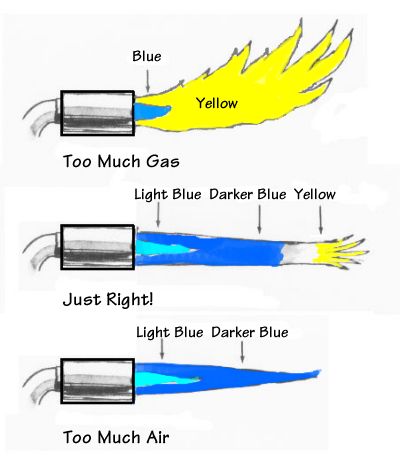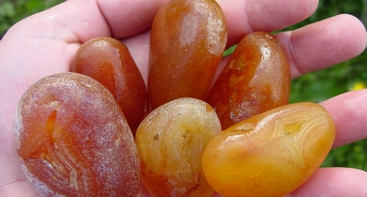Post by 1dave on Jan 22, 2014 20:18:08 GMT -5

Heat.
Alcohol Lamp temperature:
The surface temperature of burning alcohol is around 500 ̊F (260 ̊C).
As the tip of the flame burns white and has the capacity to heat glass rods sufficient to bend them, heat steel wire to a bright orange, and just barely melt copper wire the max heat of an alcohol lamp is in the region of 1100 ̊C.
The temperature an object reaches depends on the size of the flame, the location in the flame, the size of the object, and how well it dissipates heat.
Flame Temperatures:
Fuel ............... Flame Temperature
alcohol lamp ............... 260-1,100 ̊C ..... (500-2,112 ̊F, air)
cigarette .................... 400-700 ̊C ..... (750-1,300 ̊F, air)
candle ......................... 1,000 ̊C ......... (1,800 ̊F, air)
blowtorch ...................... 1,300 ̊C ......... (2,400 ̊F, air)
Bunsen burner ............ 1,300-1,600 ̊C ....(2,400-2,900 ̊F, air)
ethane ..........................1,960 ̊C (air)
butane ..........................1,970 ̊C (air)
propane butane mix ..............1,970 ̊C (air)
oxy-hydrogen ................... 2,000 ̊C or more . (3,600 ̊F, air)
carbon monoxide ................ 2,121 ̊C (air)
hydrogen ....................... 2,660 ̊C (oxygen), 2,045 ̊C (air)
natural gas .................... 2,770 ̊C (oxygen)
methane ........................ 2,810 ̊C (oxygen), 1,957 ̊C (air)
propane ........................ 2,820 ̊C (oxygen), 1,980 ̊C (air)
propylene ....................... 2870 ̊C (oxygen)
MAPP ........................... 2,980 ̊C (oxygen)
acetylene ...................... 3,100 ̊C (oxygen), 2,400 ̊C (air)
Solder should melt 150 - 250 ̊F below the melting points of the metals being joined.
The Flow Point for most solders is 45-85 ̊F above their melting points.
Soft solder usually contains high amounts of soft metals like tin and lead. The purpose of soft solder is to bridge a gap. Unlike hard solder, soft soldered joints become brittle with successive heatings. Also a soft soldered joint cannot be filed flush, because the strength of a soft soldered joint comes from the "encasing" of the joint ends by the solder.
Hard solders are made of a high temperature metal such as silver, with a small amount of tin to lower the melting temperature.
Hard solder connects two pieces of metal by expanding into the pores opened by high temperatures.
Generally, hard solder forms a stronger joint than soft solder.
As long as a hard solder joint is protected with borax or yellow ochre, the melting point of the joint metal will rise with each successive heating.
Silver Solder .. Melt Temp .. Flow Temp .. % Silver
Easy-Flo ........... 681 ̊C-1270 ̊F ......... 1320 ̊F ...50%
Easy ............... 711 ̊C-1325 ̊F ..........1375 ̊F ...60%
Medium ............. 747 ̊C-1390 ̊F ..........1440 ̊F ...70%
Hard ............... 773 ̊C-1425 ̊F ......... 1475 ̊F ...76%
Good Info: ajh-knives.com/soldering.html
14k Gold Solders
Easy ........ 1160 ̊F
Medium ...... 1410 ̊F
Hard ........ 1450 ̊F
18k Gold Solders
Easy ........ 1390 ̊F
Medium .......1485 ̊F
Hard .........1520 ̊F
Metals ......... Melting points:
Mercury ..............-38.86̊C ........-37.95̊F
Phosphorus .............. 44̊C ...........111̊F
Sodium ............... 97.83̊C ...........208̊F
Tin .................... 232̊C .........449.4̊F
Cadmium ................ 321̊C .......... 610̊F
Lead ................. 327.5̊C .......... 621̊F
Zinc ................. 419.5̊C .......... 787̊F
Magnesium .............. 650̊C ......... 1200̊F
Aluminum ............... 660̊C ......... 1220̊F
Silver, Coin ........... 879̊C ......... 1615̊F
Sterling S ............. 893̊C ......... 1640̊F
Brass 70/30 ............ 954̊C ......... 1750̊F
Silver ............... 960.5̊C ......... 1761̊F
Gold ...................1063̊C ......... 1945̊F
Copper ................1083 ̊C ......... 1981̊F
Iron Gry Cast ....1127-1204 ̊C .. 2060 - 2200̊F
Iron Ductile .......... 1149̊C ......... 2100̊F
Monel ................. 1300̊C ......... 2370̊F
Nichrome .............. 1400̊C ......... 2550̊F
Silicon ............... 1411̊C ......... 2572̊F
Steel, Carbon .... 1425-1540̊C .. 2600 - 2800̊F
German S .............. 1450̊C ......... 2642̊F
Nickel ................ 1453̊C ......... 2651̊F
Iron Wrought ..... 1482-1593̊C .. 2700 - 2900̊F
Steel Stainless ........1510̊C ......... 2750̊F
Iron .................. 1539̊C ......... 2802̊F
Palladium ............. 1555̊C ......... 2829̊F
Titanium .............. 1675̊C ......... 3047̊F
Platinum .............. 1773̊C ......... 3224̊F
Chromium .............. 1860̊C ......... 3380̊F
Rhodium ............... 1966̊C ......... 3571̊F
Iridium ............... 2355̊C ......... 4449̊F
Niobium ............... 2468̊C ......... 4474̊F
Ruthenium ............. 2500̊C ......... 4530̊F
Molybdenum ............ 2620̊C ......... 4750̊F
Osmium ................ 3066̊C ......... 5550̊F
Tungsten .............. 3400̊C ......... 6150̊F
Annealing




 Da Rules are up above in the Sales Department:
Da Rules are up above in the Sales Department:







 You're down here in the bilges with the wharf rats. You will get more mileage above on the upper decks.
You're down here in the bilges with the wharf rats. You will get more mileage above on the upper decks.

